Complete blood count (CBC):- Part 1 – Differential count With Platelets, Peripheral blood Smear Interpretations
Complete blood count (CBC)
Sample for Complete blood count (CBC)
- The best sample is blood in EDTA (Ethylene diamine tetraacetic acid).
- Also, prepare fresh peripheral blood smears.
- This is inexpensive, easy to perform, and rapidly done as a screening test.
- The sample can be obtained from:
- Capillary blood can be obtained from the fingertips, heel, or big toe. This is mostly done in newborns and infants.
- Venous blood can be obtained from the Anticubital vein, veins from the wrist area, or from any area where the vein is prominent.
Indications for complete blood count (CBC):
- It is a general screening test and gives tremendous information about the hematological system and other organ systems.
- It will differentiate between acute and chronic infection.
- It will diagnose and type the anemia.
- It will diagnose any type of leukemia.
- These are easy, inexpensive, and rapid to perform.
- It will find any abnormality in the count of platelets.
Precautions for Complete blood count (CBC):
- Physical activity and stress may cause an increase in WBCs and differential values.
- Pregnancy in the final months may cause an increase in WBC count.
- Patients with splenectomy have a persistent mild increase in the WBC count.
- Drugs that may increase the WBC county are:
- Aspirin.
- Allopurinol.
- Steroids.
- Quinine.
- Epinephrine.
- Adrenaline.
- Chloroform.
- Heparin.
- Drugs that will decrease the WBC count:
- Antibiotics.
- Anticonvulsant.
- Antimetabolites.
- Antithyroid drugs.
- Diuretics.
- Sulfonamides.
- Barbiturates.
- Chemotherapy.
Definition of Complete blood count (CBC):
- Complete blood count (CBC) includes:
- WBC count is 1 cmm in the peripheral blood.
- Differential count on the peripheral blood smears with their concentration.
- RBC count and morphology.
- Peripheral blood smears give much diagnostic information simply stained with Wright and Giemsa stain.
- The best area for appreciating the different cells in the peripheral smear is no overlapping of the cells.
- Hemoglobin gives a reddish-orange appearance to the stained cells.
Complete blood count (CBC) consists of:
- This is the differential of white blood cells (polys, lymphocytes, monocytes, basophils, and eosinophils).
- Morphology of the red blood cells.
- Hemoglobin estimation (hemoglobin which carries the oxygen).
- Hematocrit.
- Platelets count.
- Peripheral blood smears and studies include:
- RBC count.
- Hemoglobin.
- Hematocrit.
- RBC indices.
- Mean corpuscular volume (MCV).
- Mean corpuscular hemoglobin (MCH).
- Mean corpuscular hemoglobin concentration (MCHC).
- Red blood cell distribution width (RDW).
- The White cell differential count includes.
-
- Neutrophil count.
- Lymphocytes.
- Monocytes.
- Eosinophils.
- Basophils.
- Platelets count.
-
Advantages of Complete blood count (CBC):
- These are inexpensive, easy, and can rapidly be done as a screening test.
- These are the basic workup of any patient with H/O fever or any other problem to advise the complete blood count.
The peripheral blood smear shows:
Red blood cells:
- The number of red blood cells and their morphology.
- There is minimal variation in size, shape, and staining of the RBCs called normocytic cells.
- A variation in the size of RBCs is called anisocytosis.
- A variation in the shape of RBCs is called poikilocytosis.
- Hypochromia is a decrease in the intensity of hemoglobin staining. It is seen when the central pallor of RBCs is >1/3 of the diameter of RBCs.
Red blood cell abnormalities seen on peripheral blood smear:
| Type of abnormality of RBCs | Characters of RBCs | Importance of abnormality of RBCs |
| Microcytosis (microcytes) |
|
|
| Macrocytosis (macrocytes) |
|
|
| Anisocytosis | The variable size of the RBCs |
|
| Poikilocytosis | The variable shape of the RBCs |
|
| Spherocytosis |
|
|
| Elliptocytosis | RBCs are oval in shape. |
|
| Acanthocytosis | Irregular spiculated surface RBCs |
|
| Echinocytosis | Regular spiculated surface RBCs |
|
| Target cell (leptocytosis) | Hypochromic RBCs with the small central zone Hb |
|
| Stomatocytosis | The elongated central zone of pallor in the RBCs |
|
| Hypochromasia | The increased central pallor of the RBCs | Low hemoglobin |
| Polychromasia | Presence of RBCs that are not fully hemoglobinized | Reticulocytosis |
White blood cells:
- The number of white blood cells, various types, and their morphology:
- WBCs are distinguished from RBCs by the presence of the nucleus.
- The automated machine counts all the nucleated cells’ RBCs as WBCs, so it needs to be corrected if nucleated RBCs are present in the blood.
- Differential white cell count gives the proportion of the different ype of white cells like neutrophils, lymphocytes, eosinophils, monocytes, and basophils.
- Visual examination of the stained slides gives the exact picture.
What is the normal differential of white blood cells:
| Type of cells | % in peripheral smear | Absolute values |
| Segmented neutrophils | 50 to 70 | 2400 to 75000/cmm |
| Band form | 2 to 6 | 100 to 650 /cmm |
| Lymphocytes | 20 to 40 | 1000 to 4750 /cmm |
| Eosinophils | 0 to 4 | 0 to 450/cmm |
| Monocytes | 2 to 9 | 100 to 700 /cmm |
| Basophils | o to 2 | 0 to 200 /cmm |
Granulocytes:
- These are white blood cells containing visible granules in the cytoplasm. Granules are the following types:
- Neutrophils have neutral staining.
- Eosinophils show reddish eosinophilic granules.
- Basophils show bluish granules.
- Monocytes show a convoluted nucleus and are large in size.
Neutrophils or polymorphonuclear leukocytes (PMN or polys):
- 50% to 70% are mature granulocytes (segmented neutrophils) on the peripheral blood smear.
- The neutrophils’ cytoplasmic granules react with both basic and acidic stains, producing neutral or light purple granules.
- There is a characteristic dense nucleus with 2 to 5 lobes and usually 3 lobes connected by the filament.
- The nuclear chromatin is heavily clumped, coarse, or pyknotic, and stains purplish red.
- In the mature neutrophils, the Nucleochromatin is condensed into discrete lumps or lobes.
- Roughly 6% of neutrophils have one lobe called band form.
- 35% have two lobes.
- 41% have three lobes.
- 17% have four lobes.
- 2% have five lobes.
- The cytoplasm is pale with irregular outlines containing many fine pink-blue (azurophilic) or grey-blue granules.
- The life span of PMN in the peripheral blood is 6 to 10 hours.
- Band forms have less mature nuclei.
- Neutrophils are actively mobile, and many cells can gather at the site of inflammation or infection, called chemotaxis.
Functions of neutrophils:
- Neutrophils are the first line of defense against tissue injury or foreign microbes.
- Segmentation of the nucleus enables these motile cells to pass through the opening of the endothelium of capillaries and target foreign substances like microorganisms.
- Neutrophils may activate the complement system.
- Induce immunoglobulin production.
- They can do phagocytosis and degrade some particles.
- They can produce an enzyme, which can destroy foreign substances ingested or phagocytosed.
- The neutrophil cytoplasm contains granules:
- Primary granules are myeloperoxidase, acid phosphatase, and other acid hydrolases.
- Secondary granules are alkaline phosphatase, lysozyme, and lactoferrin.
Eosinophils:
- Normal adult blood shows 0 to 4% (1 to 5%) in the peripheral blood smear.
- Eosinophils are easily recognized by eosinophilic granules in the cytoplasm and affinity the acid eosin stain.
- In Wright’s stain, the granules are orange to reddish-orange.
- The granules are of uniform size, spherical, and evenly distributed.
- Size is slightly larger than the neutrophils and two lobes with condensed chromatin. Rarely can see three lobes.
- There is diurnal variation in the eosinophils count, with an increase at night and a decrease in the morning.
The function of eosinophils:
- These have a special role in allergic reactions.
- These are very important in parasitic defense.
- These play a role in the removal of fibrin formed during inflammation.
Monocytes:
- In the DLC’s thin areas, these measure 15 to 18 µmand are larger than the neutrophils.
- There is abundant cytoplasm compared to the nucleus ( N: C = 2:1).
- With Wright’s stain, the cytoplasm turns dull grey-blue compared to the pink cytoplasm of the neutrophils.
- The nuclei of monocytes may be kidney-shaped, folded, indented, or occasionally lobulated.
- The nucleus shows convolutions like the brain or like a turban.
- The shape of monocytes is variable, maybe round or with blunt pseudopods.
- Four important features of the monocytes are:
- Nuclear convolutions.
- Lacy or Often delicate chromatin.
- Dull grey-blue cytoplasm.
- Blunt pseudopods.
- Digestive vacuoles may be seen in the cytoplasm.
- The half-life is 8 hours to 3 days before these cells enter the tissues and become macrophages.
- Monocytes are 2 to 9% of the normal blood leucocytes.
Functions of monocytes:
- Defensive mechanism:
- In different conditions like infection, bacteria, fungi, pigments, and phagocytosed RBC may be seen in the cytoplasm.
- Phagocytosis.
Basophils:
- These cells are rarely found in the peripheral smear, which is 0 to 2%.
- Basophils have large, abundant violet-blue or purple-black granules in the cytoplasm.
- These granules mostly obscure the nucleus.
- These granules measure 0.2 to 1.0 µm. These vary in number, size, and shape—these are less numerous than the eosinophil’s granules.
- These granules have an affinity for the blue or basic thiazine dyes. Basophil granules are water-soluble.
- Basophils show diurnal variation like eosinophils, increasing at night and decreasing in the morning.
Functions of basophils:
- In the tissue, they become mast cells.
- These cells have a receptor for the IgE.
- On degranulation, produce histamine.
Lymphocytes:
- Lymphocytes are the second most numerous cells in the peripheral blood smears.
- Lymphocytes are 20% to 40% of adult blood cells.
- Lymphocytes are small, varying in size from 7 to 10 µm. There are intermediate and large lymphocytes.
- Wright’s stain gives blue cytoplasm varying in intensity from light to dark in different cells.
- Most lymphocytes don’t have granules.
- The nucleus size in small lymphocytes is just the size of RBCs in the same microscopic field.
- The nucleus /cytoplasm ratio is 4:1, and nuclei are round or slightly indented.
- Chromatin structure is lumpy or clumped and stains dark purple with a lighter bluish-purple area between chromatin aggregates.
- Functions of lymphocytes:
- Their main function is humoral immunity.
- B-L produces an antibody-dependent immune reaction.
- T-lymphocytes help B-lymphocytes and give rise to cell-mediated immunity.
Platelets:
- Platelets are produced in the bone marrow by the fragmentation of the cytoplasm of megakaryocytes.
- Each megakaryocyte gives rise to 1000 to 5000 platelets.
- The size of the platelets is 2 to 4 µm in diameter and varies in shape.
- The average number of platelets is 7 to 15/oil immersion field.
- Estimate the number of platelets in 10 oil immersion fields.
- Platelets are mostly seen in groups.
- It is necessary to count the number of platelets in the group.
- Platelets have no nucleus.
- The normal platelets are 250 x 109/L, ranging from 150 to 400 x 109/L.
- The normal life span of the platelets is 7 to 10 days. About 1/3 of the marrow output of platelets is trapped in the spleen, and it will increase in case of splenomegaly.
Structure of the platelets:
- The platelets are the smallest structure in the peripheral blood smear and this measure 3.0 x 4.0 µm in diameter with a mean volume of 7 to 10 fl.
- The larger platelets are >4.0 µm.
- Giant platelets measure >7.0 µm.
Functions of platelets:
- The surface coat’s glycoproteins are important in the platelet’s reactions of adhesion and aggregation, which are the initial events in the platelet plug formation in the process of hemostasis.
- The plasma membrane phospholipids (known as platelets factor 3) are important in the conversion of coagulation factor X to Xa and prothrombin (factor II) to thrombin (factor IIa).
- The platelets contain three types of granules:
- α-granules:
- Contains a heparin antagonist.
- Platelets-derived growth factor (PDGF).
- β-thromboglobulin.
- Fibrinogen.
- VWF and other factors.
- Dense granules contain:
- Adenosine diphosphate (ADP).
- Adenosine triphosphate (ATP).
- 5-hydroxytryptamine (5-HT).
- Calcium.
- Lysosomes contain:
- Hydrolytic enzyme.
- Peroxisomes contain catalase.
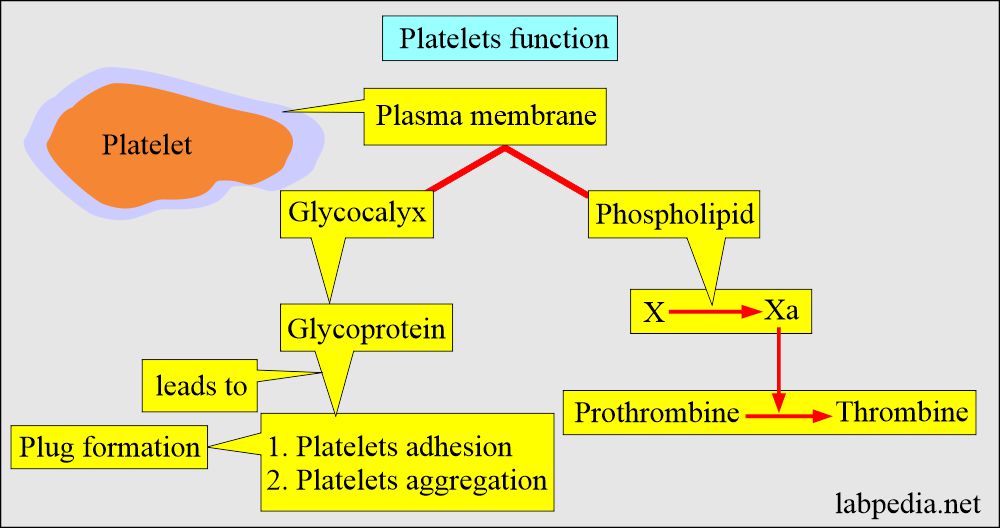
Summary of the Cytochemistry of various cells found in the peripheral blood:
| Types of the cells | Peroxidase | Nonspecific esterase | Periodic Acid-Schiff (PAS) | Acid phosphatase |
| Segmented neutrophils | Positive (++) | Positive (+) | Positive (++) | Diffusely positive |
| Band neutrophils | Positive (++) | Positive (+) | Positive (+ to ++) | Diffusely positive |
| Eosinophils | Positive (++) | Negative | Negative (Cytoplasm +) | Diffusely positive |
| Basophils | Partly positive | Negative | Positive (++) | Negative |
| Monocytes | Negative to positive (- to +) | Positive (++) | Diffusely positive (+) | Positive (++) |
| Lymphocytes | Negative |
Focal locally positive (+) (Acid esterase ) |
Granules partly positive (+) | Often positive (+), Fine granules, and focal |
| Platelets | Negative | Positive (+) | Positive (+) | Positive (+) |
What is the normal value of the cells in Peripheral blood smear:
Normal Peripheral blood (CBC):
- TLC is total leucocytes count:
- 4,100 to 10900/cmm.
- DLC is differential count. Normal values:
- Neutrophils = 48 % to 77 %
- Lymphocytes = 10 % to 40 %
- eosinophils = 0.3 % to 7 %
- Monocytes = 0.6 % to 9.6 %
- Basophils = 0.3 to 1 %
- Platelets = 140,000 to 400,000 /cmm
What is the normal Hemoglobin?
Source 2
- Male 14 to 18 g /100 ml
- Female 12 to 16 g/ 100 ml
- Pregnant female = >11 g/dL
- Old people’s values are slightly low.
Source 1
| Age | Hb g/dL | Hb g/dL Male | Hb g/dL Female |
| Fetal blood | |||
| 18 to 20 weeks | 11.47 ± 0.78 | ||
| 21 to 22 weeks | 12.28 ± 0.89 | ||
| 23 to 25 weeks | 12.40 ± 0.77 | ||
| 26 to 30 weeks | 13.35 ± 1.17 | ||
| Infants | |||
| Cord blood | 13.5 to 20.5 | ||
| 1 month | 10.7 to 17.1 | ||
| 2 month | 9.0 to 13.0 | ||
| 4 month | 10.3 to 14.1 | ||
| 9 month | 11.4 to 14.0 | ||
| one year | 11.3 to 14.1 | ||
| 2 to 5 year | 11.0 to 14.0 | ||
| 5 to 9 year | 11.5 to 14.5 | ||
| 9 to 12 year | 12.0 to 15.0 | Male | Female |
| 12 to 14 year | 12.0 to 16.0 | 11.5 to 15.0 | |
| 15 to 17 year | 11.7 to 16.6 | 11.7 to 15.3 | |
| 18 to 44 year | 13.2 to 17.2 | 11.7 to 15.5 | |
| 45 to 64 year | 13.1 to 17.2 | 11.7 to 16.0 | |
| 65 to 74 year | 12.6 to 17.4 | 11.7 to 16.1 |
- For conversion into SI units x 10 = g/L
- Critical value = <5 g/dL or >20 g/dL
What is the normal ESR (erythrocyte sedimentation rate):
Normal
- Male Older than 50 years = 0 to 15 mm/ hour
- Female = 0 to 25 mm /hour
- Child = up to 10 mm/hour
- Newborn = 0 to 2 mm/hour
What is the normal Platelet count:
- Adult = 140,000 to 400,000/cmm
- Children = 150,000 to 450 000/cmm
- Platelets are assessed by the smear or by a hematology analyzer.
What are the causes for increased Neutrophils:
- Infections.
- Myocardial infarction.
- Stress.
- Metabolic diseases.
- Inflammations.
What are the causes of decreased Neutrophils:
- In radiation therapy or chemotherapy.
- Infections.
- Hypersplenism.
- Folic acid or B12 deficiency.
- Hepatic diseases.
- Drugs
- collagen vascular diseases.
What are the causes of increased Eosinophils:
- Allergy.
- Parasitic infestation.
- Skin disorders.
- Neoplastic diseases like Hodgkin’s lymphoma.
- Collagen vascular diseases.
What are the causes of decreased Eosinophil:
- Cushing’s syndrome.
- Stress.
What are the causes of increased Lymphocytes:
- Chronic infections.
- Lymphocytic leukemia.
- In immune diseases, e.g, Ulcerative colitis.
What are the causes of decreased Lymphocytes:
- Chronic debilitating illness.
- Immune-deficiency.
What are the causes of increased Monocytes:
- Infections.
- Collagen vascular diseases.
- Carcinoma.
- Monocytic leukemia.
- Lymphoma.
What are the causes of increased Basophils:
- Chronic myelocytic leukemia.
- Polycythemia vera.
- Hodgkin’s disease.
- In some anemias.
What are the causes of decreased Basophils:
- Hyperthyroidism.
- Stress.
- Ovulation.
- Note: please see more information on peripheral and RBC smear.
Questions and answers:
Question 1: What is the effect of hyperthyroidism on basophils?
Question 2: What are the causes of decreased eosinophil count?

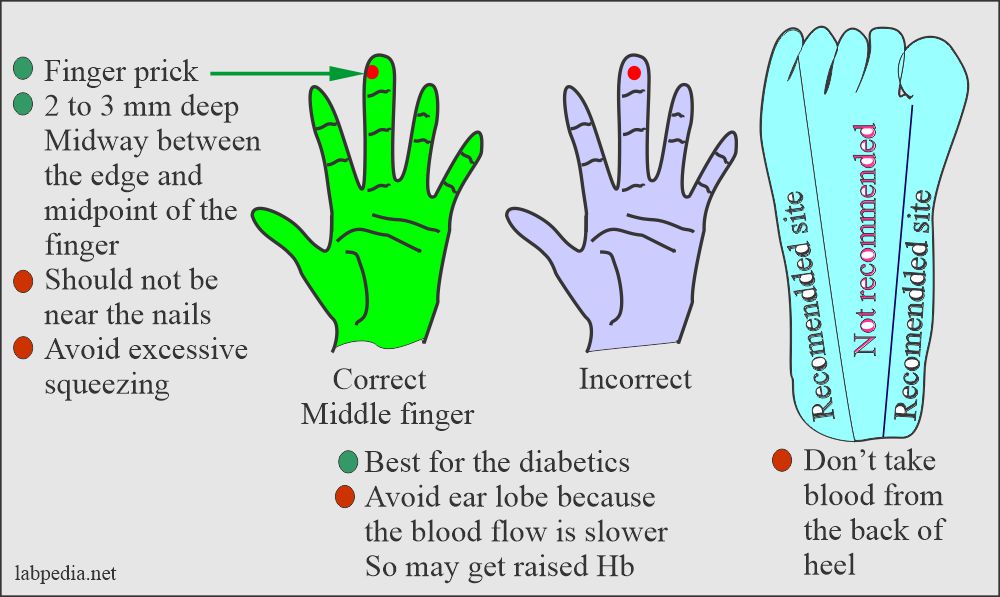
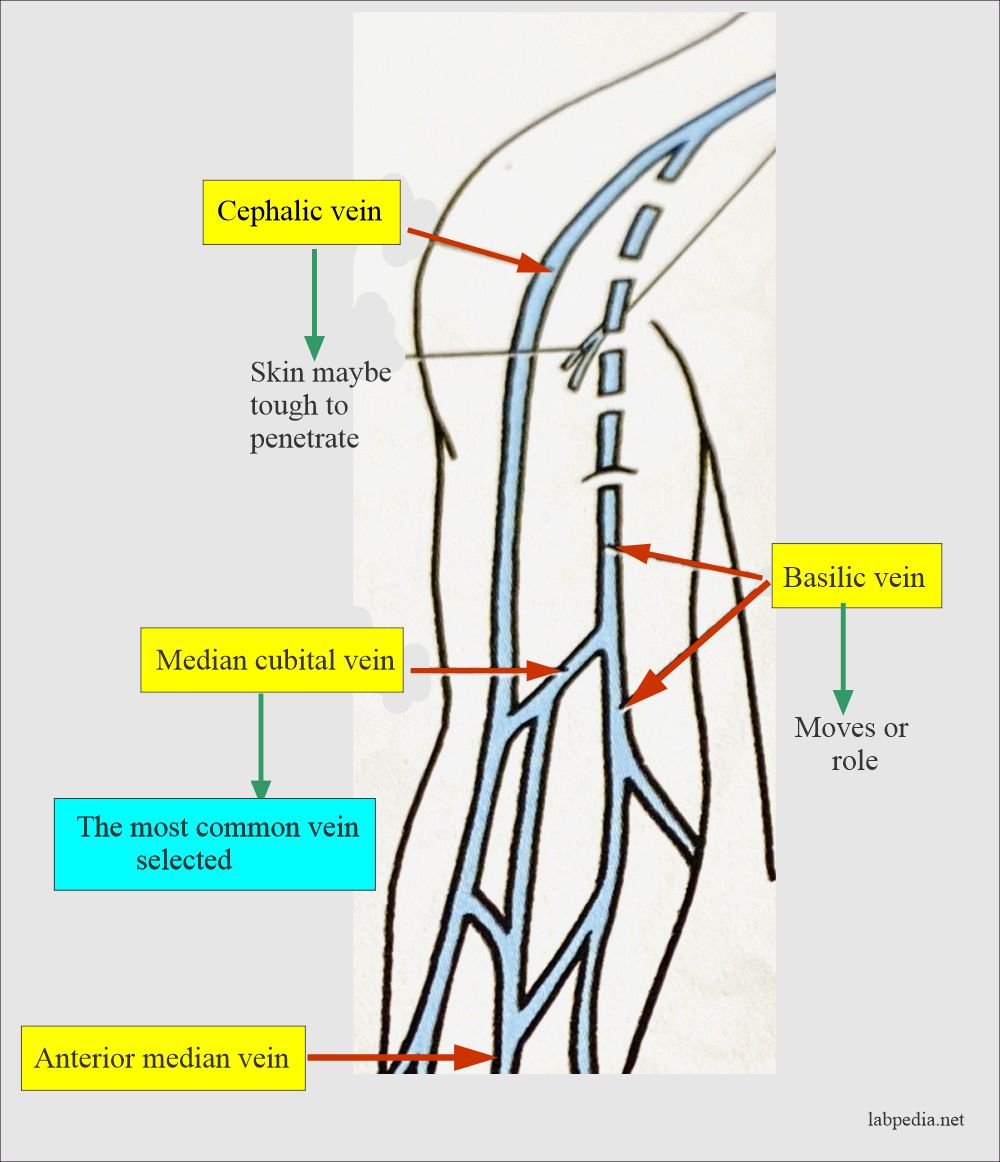
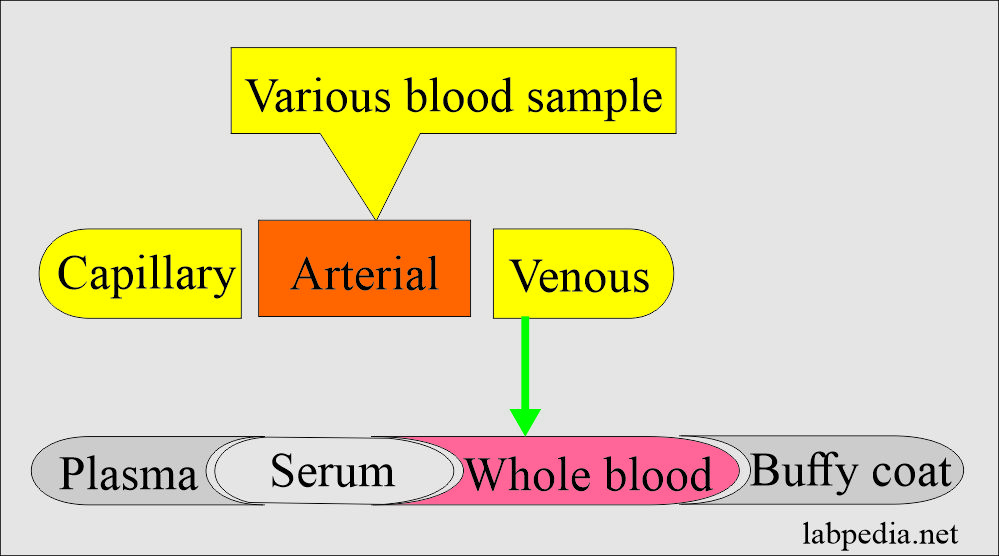
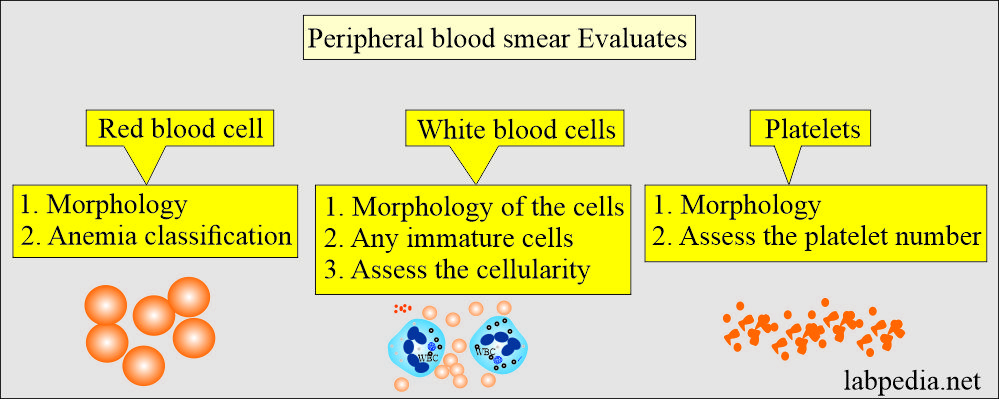
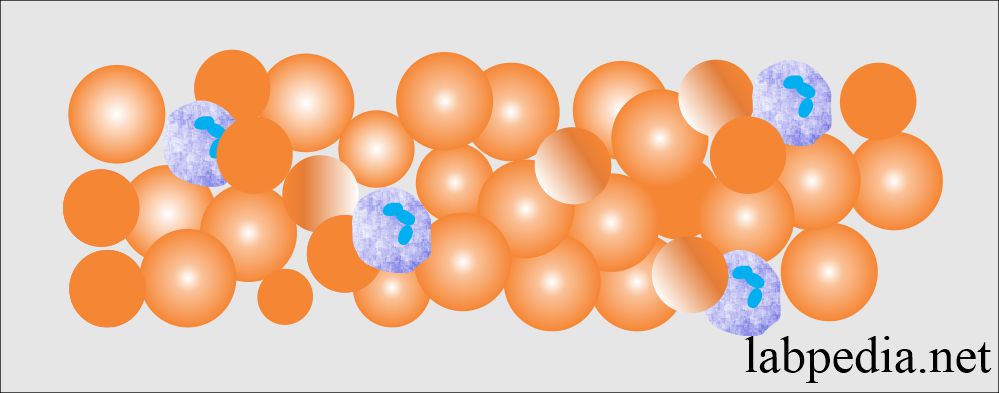
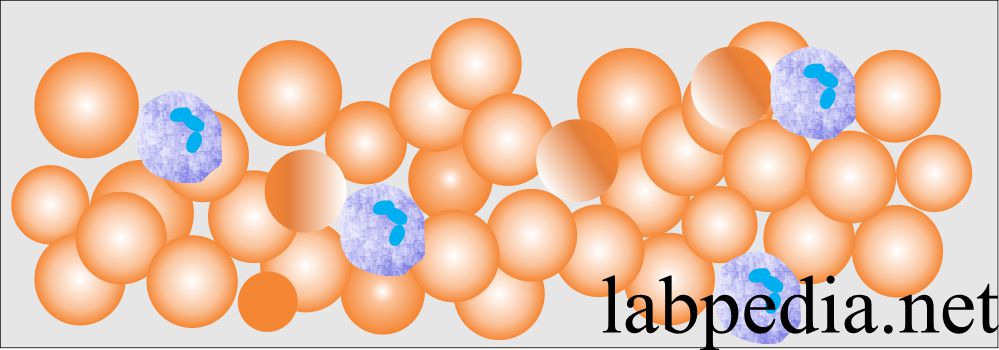
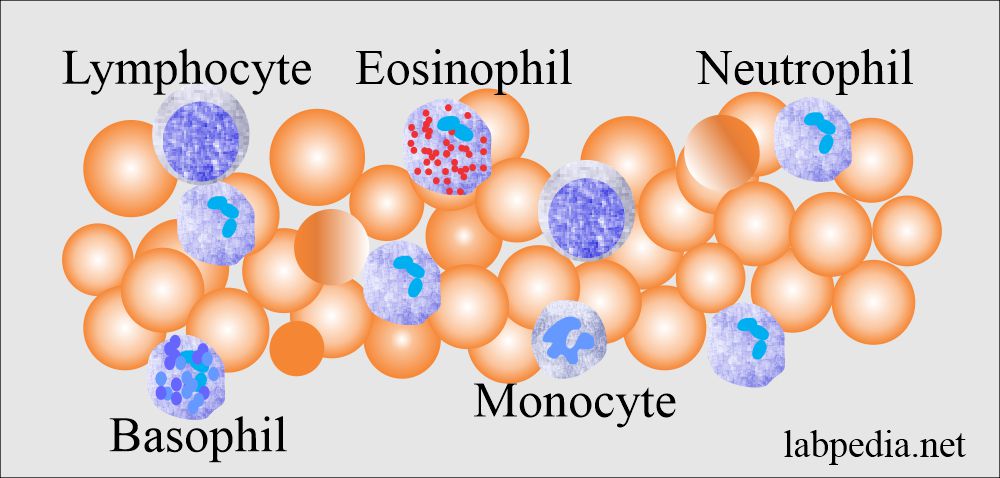
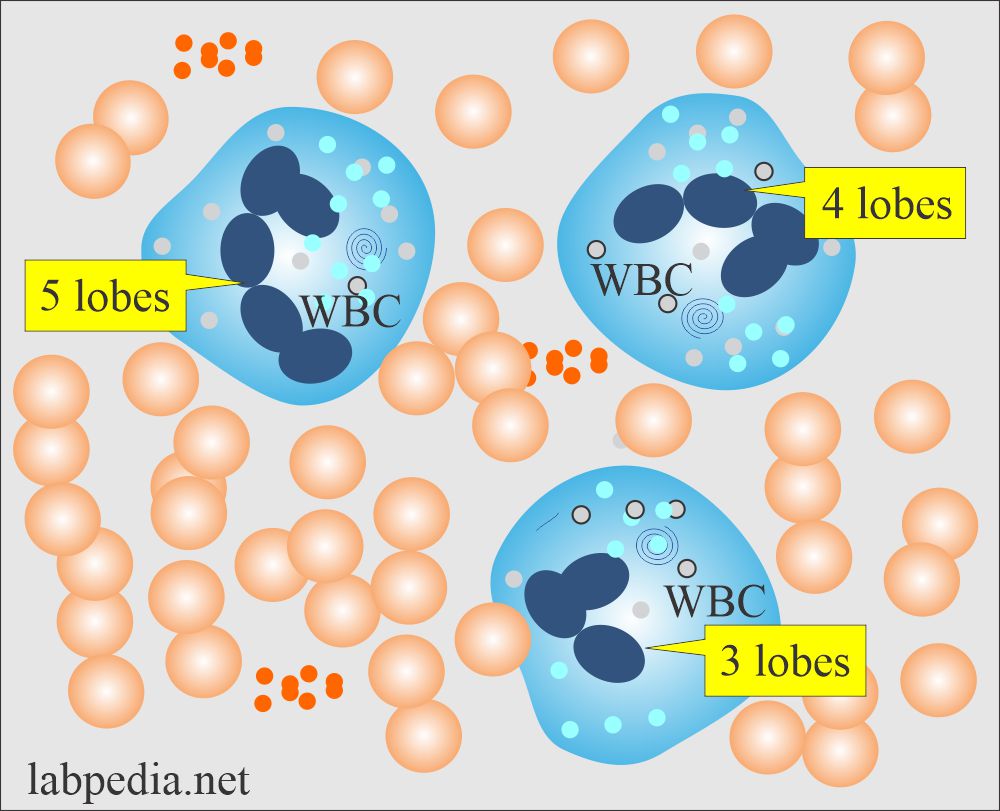
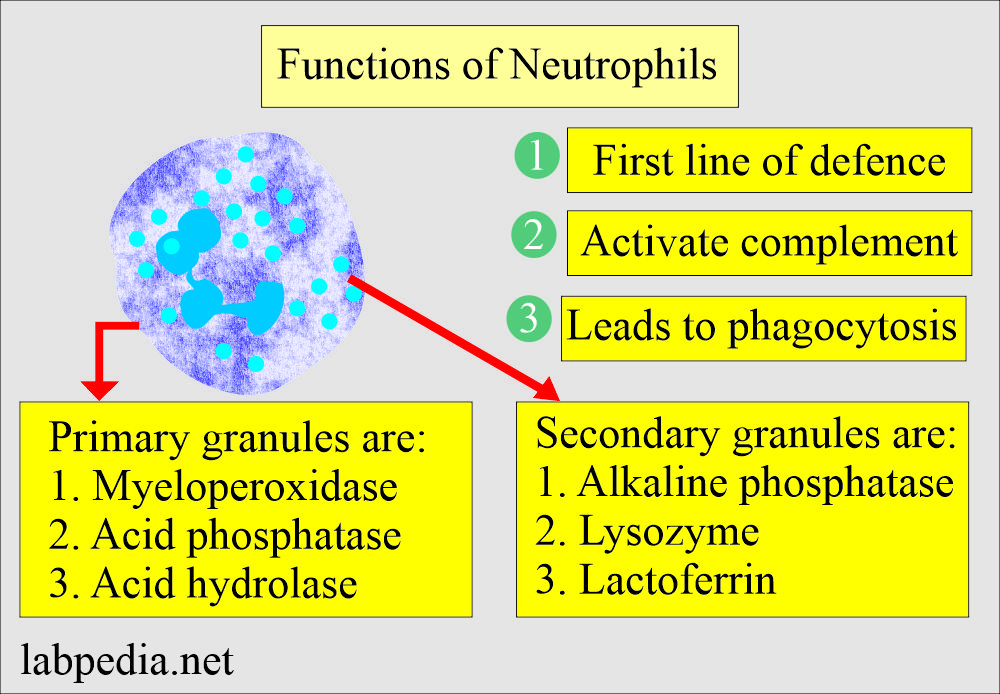
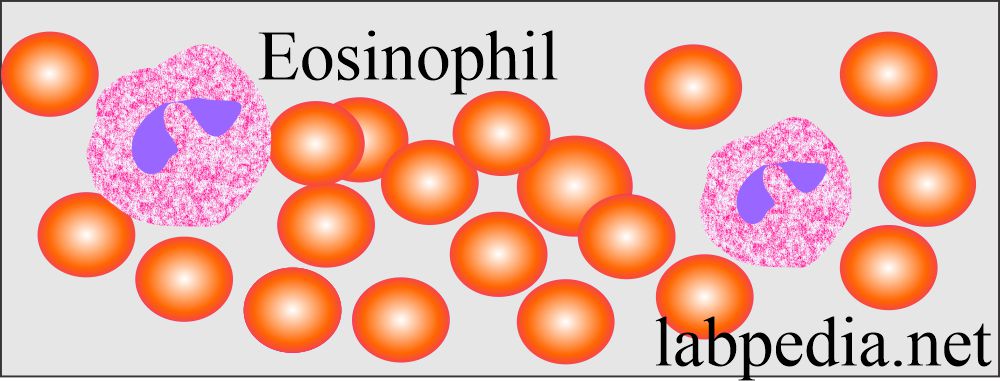
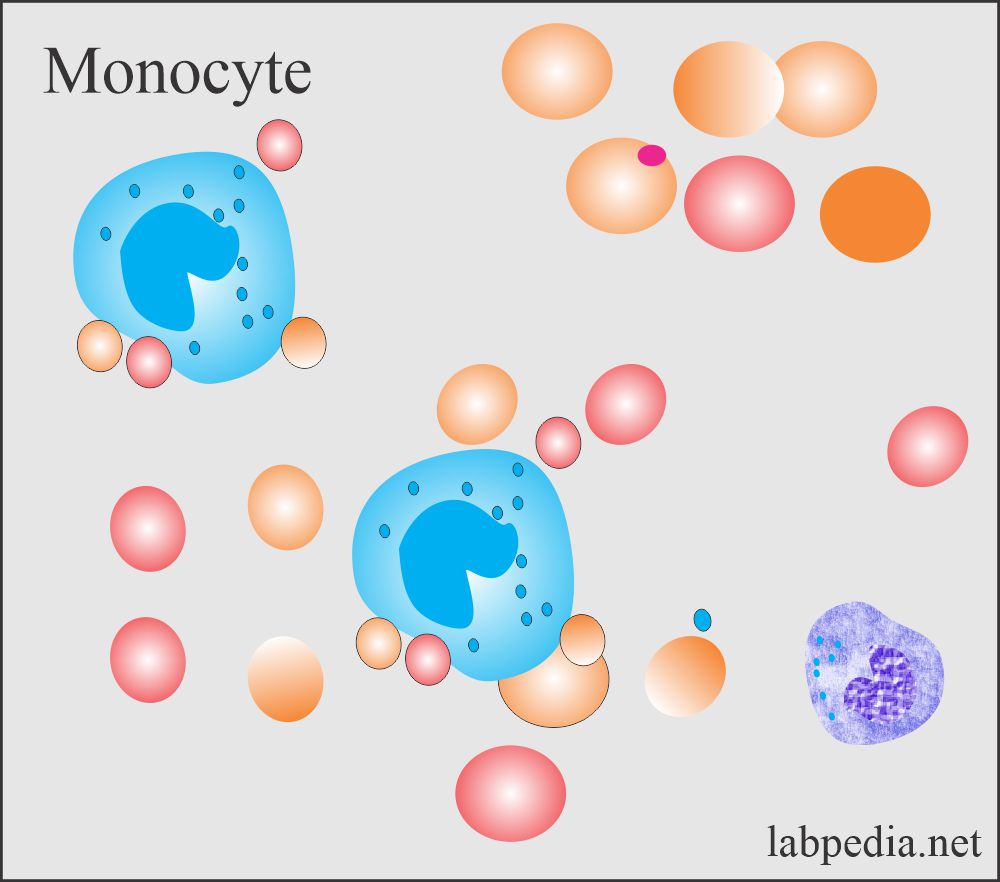
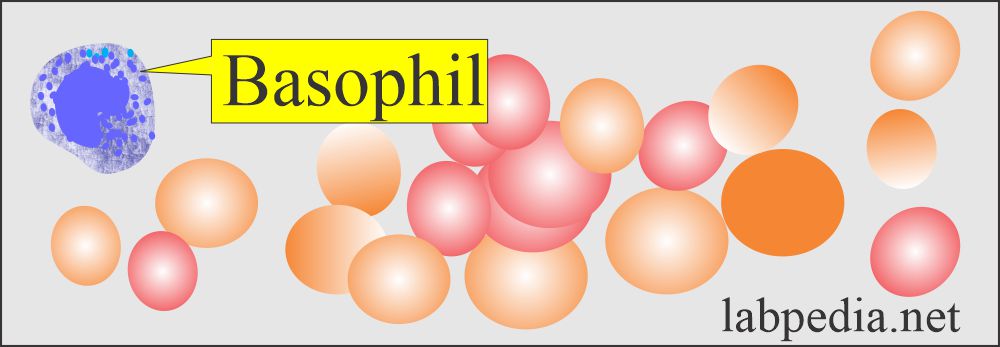
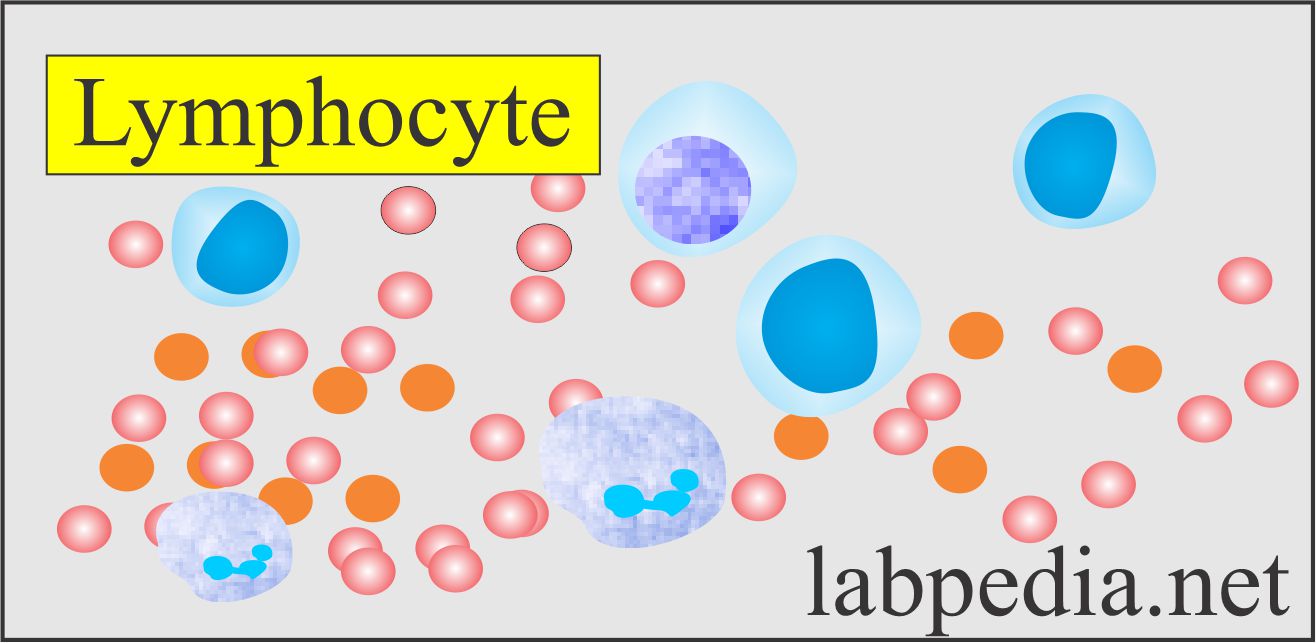
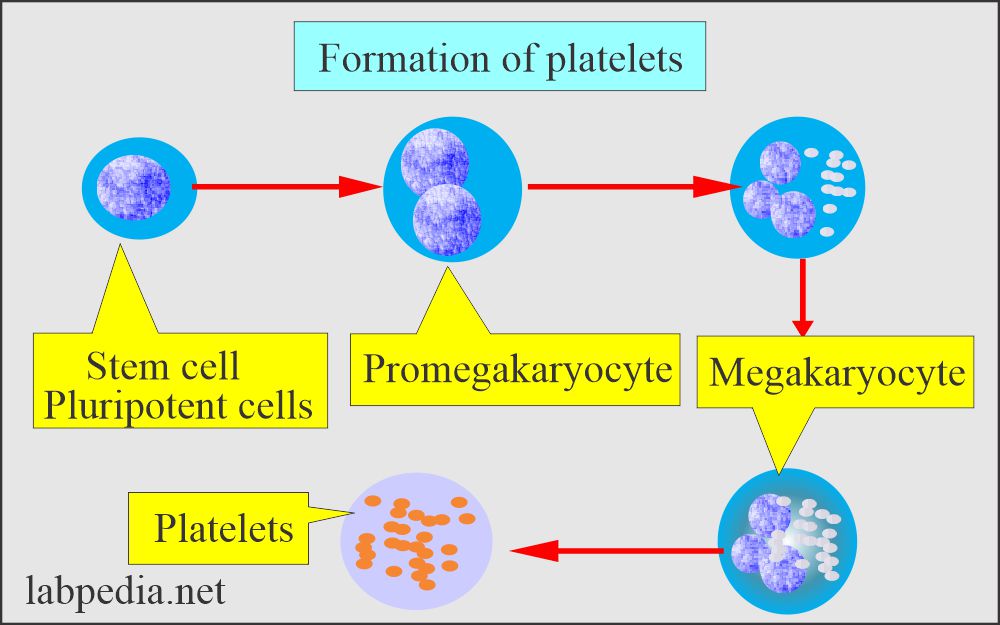
Good subject
Recently reported in a study in JAMA that megakarocytes have been found in capillaries of brain on autopsy in Covid19 patients. How they reach these capillaries?I simply don’t understand
This is really confusing for the researcher. Please read this reference.
https://www.medpagetoday.com/neurology/generalneurology/91246
Plz send
May I know what you want?
what does slightly increased platelet distribution mean? peripheral blood smear shows: poikilocytosis, sickle cells and occasional target cells, hypochromic and microcytic cells, and normal WBC morphology.
Please see this comment:
Platelet distribution width (PDW) is a measurement of platelet anisocytosis calculated from the distribution of individual platelet volumes. Thrombocrit (or plateletcrit) is the percentage of blood volume occupied by platelets and is an assessment of circulating platelet mass.